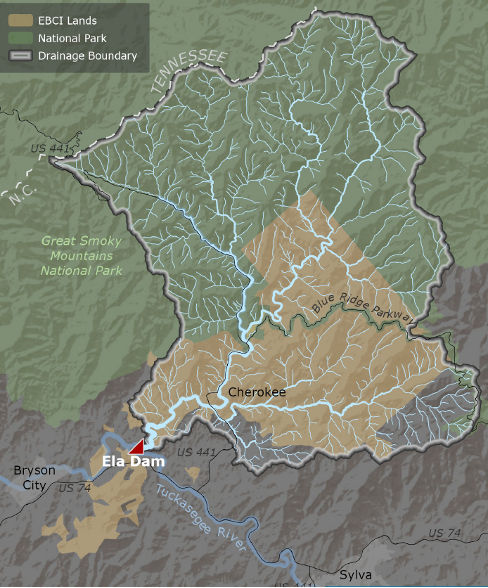Coalition led by Eastern Band of Cherokee Indians works to remove the Ela Dam

The Oconaluftee River starts as a trickle high on the North Carolina-Tennessee border in Great Smoky Mountains National Park. The river grows as it flows through the Qualla Boundary — modern-day home of the Eastern Band of Cherokee Indians — and under the Blue Ridge Parkway before emptying into the Tuckasegee River near Bryson City, N.C. Nearly 100 years ago, the Ela Dam was constructed just upstream of the confluence of these two rivers, disconnecting the Oconaluftee watershed from waters downstream.
A coalition convened by Joey Owle, Secretary of Agriculture for the Eastern Band of Cherokee Indians, is now working to reconnect the watershed by removing the Ela Dam.
“The Cherokee have always had a strong relationship with water, and the Ela Dam has disconnected us for nearly a century. With a team of exceptional partners, this is an opportunity of a lifetime for our people,” says Owle. The coalition includes the dam owner, Northbrook Carolina Hydro II, American Rivers, Mainspring Conservation Trust, the North Carolina Wildlife Resources Commission, U.S. Fish and Wildlife Service, the U.S. Army Corps of Engineers, and SELC, among others. All of the groups have identified this as a once-in-a-lifetime opportunity to reconnect a free-flowing Oconaluftee River, restore habitat and species diversity, and pursue environmental justice for the Eastern Band of Cherokee Indians.

Importantly, dam removal will restore habitat for the sicklefin redhorse — a threatened fish endemic to only a few rivers in the Southern Appalachians that was once an important element of the Cherokee diet. The dam has blocked the migration route for the fish, disrupting centuries of cultural connection by effectively eliminating it from tribal lands and contributing to imperiling population declines for the species. Dam removal also stands to benefit other rare species, including Eastern Hellbender and Appalachian elktoe (a federal endangered mussel).
These benefits far outweigh the small amount of electricity the dam can generate — less than 1 megawatt.

Initial studies assessing the potential for dam removal have been made possible largely by funding from the State of North Carolina through the N.C. Wildlife Resources Commission. Now the coalition is working to pursue money made available through the recent federal Bipartisan Infrastructure Law. Adequate funding for dam removal would reconnect this long-bisected watershed, improve habitat for rare species, and help strengthen the connection between the Eastern Band of Cherokee Indians and their ancestral homelands.
The coalition expects to know whether the project is selected for federal funding by summer 2023. In the meantime, the coalition continues the necessary preparations to secure removal of the dam — setting an important example of how diverse stakeholders can work together towards a common objective.
